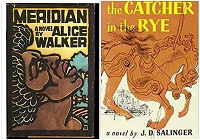How identifying with angry protagonists changes over time.

I read Alice Walker’s Meridian around the same time as J.D. Salinger’s The Catcher in the Rye. I was at home during the last Christmas vacation I would ever take there (you can’t go home again). The Color Purple had been a big, fat hit for a couple of years, and I’d struggled with it in a class during my first semester of college.
I don’t recall ever finishing that book. But I picked up Meridian because I wanted to know Walker. It was the same reason I’d picked up Salinger. I’d heard about him, and it was time for me, as a declared English major, a junior in 1985, to know him.
Thinking back now, I remember that both novels were about angry young people. Holden Caulfield — white, suburban, alienated — was like James Dean in “Rebel Without a Cause.” The character Meridian Hill — black, Southern, marginalized — was like Bob Dylan, a protest singer and rebel with a cause.
Both held the individuals of society to blame for its oppressive, unfair structures. They were both within the intellectual reach of my empathy. They both experienced things I’d seen the edges of, and they conveyed images that I was generally familiar with — small Southern towns, New York City, fancy schools, movement meetings — but about which I wanted to know more.
Hungry to know the truths about individual experiences in America, I thought I could be a poet like Whitman. I wanted to witness the deeper lives of people whose histories and futures were different than mine.
These days, I can only look at Holden Caulfield the way I look at Bobby Darin, a remnant of a long-gone past. Not without talent or merit or glory. Just done and gone. We can look now at the “phonies” and see Dylan’s Mr. Jones (who is most certainly a very old man now). And we see replicant images in such shows as “Mad Men.” But that branch is withering.
Conversely, I see Meridian Hill in many living, goal-oriented people. In the actual multicultural world (not the Jägermeister dreams of rich narcissistic sociopaths), Walker’s vision continues to resonate powerfully. Generations of people can hear their stories in Meridian’s: participating for the greater good; passionate love; divergent personalities; an unexpected pregnancy; the loss of the dreams of the future; and hope in the face of that loss.
I remember Meridian expressing outrage that the men in the Civil Rights movement were so callous to the women who supported them. She had good reason to be angry. History shows us now that Civil Rights didn’t mean the same thing to everyone.
As the years passed, I’ve come to see that Alice Walker was less like Bob Dylan and much more like (and a peer of) Toni Morrison, centralizing African-American women characters who had for so long been marginalized that the continuing marginalization was part of the story.
It remains a serious issue in the United States. Too many citizens are unable to see fellow Americans less white than they are as subjects of their own lives, deserving of the respect of being treated as subjects of their own lives. Americans, the laws they make, the police who kill, the prosecutors who deny, the juries that acquit, the journalists who tell the stories, still treat minority people like objects.
The one nonfiction woman who stands out in my mind at the moment is Diamond Reynolds, the woman and mother who was in the car with her daughter when Jeronimo Yanez shot Philando Castile seven times at close-range. I heard Meridian Hill in her outrage. I saw Meridian Hill in her bewilderment.
As her boyfriend bled out, the police handcuffed Reynolds in the back seat of their cruiser, and afterward brought her and her daughter to the police station for an interview before letting them go. (Tamir Rice’s sister was handcuffed in the back of a police cruiser, too, while Tamir slowly died.) Reynolds has reached a settlement with the city government of St. Anthony’s, Minnesota. Imagine those negotiations.
These stories have to be told. The cancer has to be put under the microscope. Who would be afraid of hearing the subjective stories of individuals for what they can tell us about our society? Only the liars and deniers, people with something to lose who are likely to cultivate hatred rather than adjust.
Of course, people still read about good old Holden Caulfield: safe, scruffy, white. To an extent, I admire Salinger, a sensitive, perceptive, spiritual writer. He observed similar hypocrisies in human beings as does Alice Walker — different milieu, same humanity.
But if you’re unwilling to do more than read about Holden Caulfield, then you’re part of the problem. The great pressure in our society today is that its institutional structures must change to accommodate the subjective lives of heretofore minority peoples who will (within a generation or two) become the majority.
We fail as citizens when we fail to understand each other. Literature has always been there so that we could do the work that will allow us to empathize with each other, to recognize our common humanity. Great artists, and great art, teach us to be better and not to be afraid.
Y.S. Fing believes “that all men are created equal [and] that they are endowed by their Creator with certain unalienable rights.”

